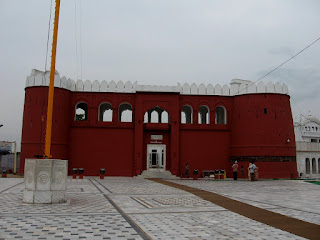Bibi Dalair Kaur
She defended Anandpur Fort against the Mughals
The early 18th century was a period of turbulence in the Punjab. Frequent wars between the Sikh, the hill kingdoms and the Mughals under Aurangzeb saw alliances between these parties being made and broken constantly.
History of Anandpur
Guru Tegh Bahadur, the ninth of the ten Sikh gurus, founded in 1665 the town of Anandpur Sahib on the banks of the river Setluj, the longest of Punjab’s five rivers. Rani Champa of Bilaspur had offered him the land during the extensive travels he undertook all over India. He met people to extend comfort and strength to the masses as atrocities on non-Muslims became rampant under Aurangzeb’s influence. His son, Guru Gobind Singh became the tenth Sikh guru.
Anandpur Fort
Guru Gobind Singh lived in Anandpur and his followers also began to settle there. The rulers of the neighbouring hill kingdoms who were allies of the Mughals were uncomfortable with this development. Hence Aurangzeb disallowed large congregations of Sikhs to assemble for their festivals such as Baisakhi. And in 1699 when Guru Gobind Singh established the Khalsa Panth, transforming the Sikhs into a martial unit of armed men and women in Anandpur to resist Mughal excesses and religious persecution, Aurangzeb responded by sending his army. This then led to several battles and skirmishes between the Sikhs and the Mughal forces.
The First Battle of Anandpur in 1700 resulted in the Mughal forces being routed. The army fled the battlefield. In the Second Battle of Anandpur in 1704, the Mughal army units were again roundly defeated by the Sikhs. Aurangzeb then sent in a second larger army to break the Sikh resistance.
This time the Mughals did not opt for open warfare but chose to lay siege to the town from May to December, effectively cutting off all supplies to Anandpur. Under these circumstances Guru Gobind Singh accepted the Mughal offer of safe passage.
Dalair Kaur in-charge
Before he left the fort however, Guru Gobind Singh handed over charge to young Dalair Kaur who had 100 Khalsa women and 10 Khalsa men with her to defend Anandpur.
Almost as soon as Guru Gobind Singh and 500 Khalsa soldiers left the fort, the Mughals and their allies reneged on their promise of safe passage. They attacked the Sikhs and a tremendous battle ensued.
Guru Gobind Singh’s family scattered. His wife and a trusted aide made their way to Delhi, his two older sons and 40 soldiers lost their lives in a subsequent battle which the guru survived, and the guru’s mother and two young sons were betrayed by a trusted aide to the Mughals, which led to their brutal execution.
In the meanwhile, at the Anandpur Fort
The Mughal army readied to walk in and claim victory over the fort at Anandpur after the battle outside. As they triumphantly neared the fort they were greeted by a hail of bullets. Bibi Dalair Kaur and her soldiers were prepared for battle, to uphold the trust the guru had reposed in them.
The sight of so many dead Mughal soldiers when he thought victory was at hand drove the general Wazir Khan into a frenzy of anger.
The Mughals now deployed their cannons and breached the wall of the fort. The Mughal army was much larger in number and better equipped, but the Sikhs were not about to give up the fort without a fight.
Bibi Dalair Kaur was a true leader even under fire. She encouraged her soldiers every step of the way inspite of overwhelming odds.
As the cry of ‘Bolay So Nihal, Sat Sri Akal’ rang out in the fort, Wazir Khan kept sending in soldiers even as the Sikhs inside began to run out of ammunition. The Sikh defenders were now ready at the breach in the wall with their swords drawn. When the Mughal soldiers clambered over the rubble to try to enter the fort they were astonished to see Khalsa women in the thick of battle, giving as good as they got. Going by the enemy’s ferocity in the earlier skirmish the Mughals had imagined a larger number of Sikhs within the fort.
Seeing his soldiers hesitate at the sight of women warriors, Wazir Khan egged them on and rode into the breach, only to be felled by a defender. The Mughal soldiers retreated again. They were unsure of how many Khalsa warriors were actually in the fort.
Now the second commander Zabardast Khan ordered for the cannons to be used. Afterwards as the Mughals now cautiously walked into the breach, they fully expected to be attacked at any moment but there was no retaliation from the Sikhs. Zabardast Khan was convinced the Sikhs were hiding to attack in full force, but even as the Mughals went deeper into the fort nothing happened.
As the Mughals began to loot the place of anything of value, they also moved the rubble from near the breach in the wall. The bodies of the Sikh defenders, Khalsa women and men were discovered there. They had fought to the last of their resources and had given their lives to defend the fort as Bibi Dalair Kaur had promised Guru Gobind Singh.
1. http://www.allaboutsikhs.com/sikh-history/bibi-dalair-kaur.html
2. www.sikhiwiki.org
